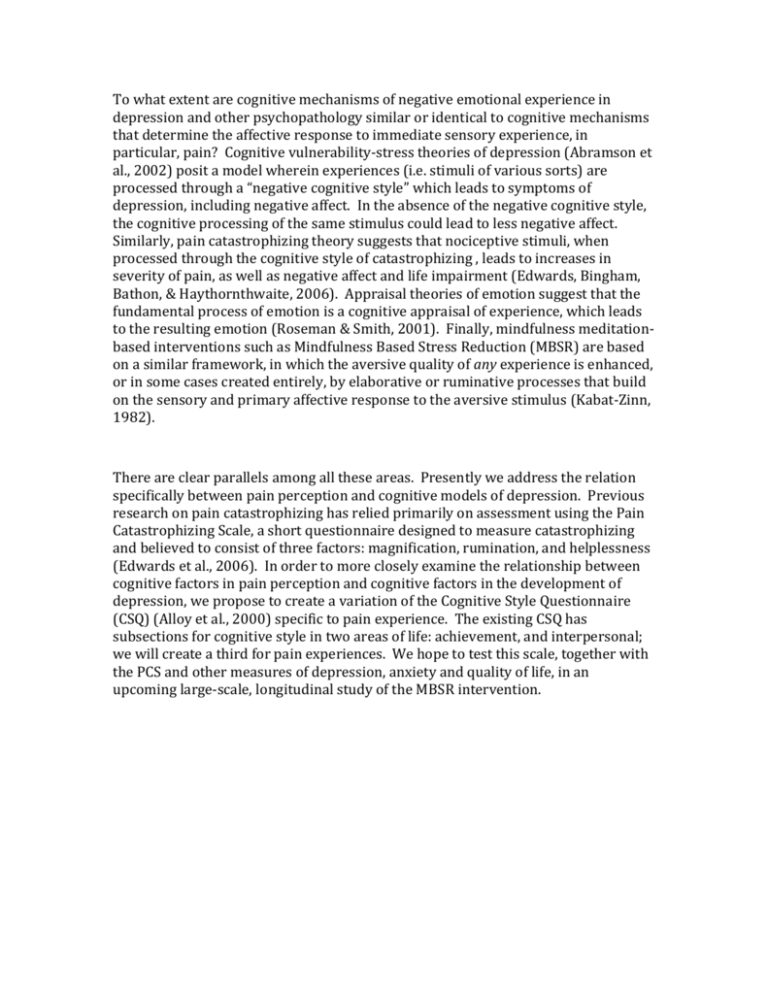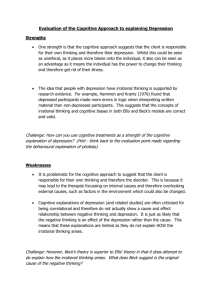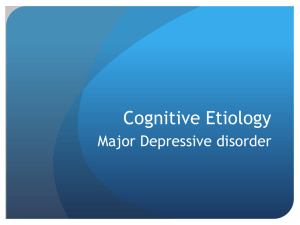To what extent are cognitive mechanisms of negative emotional
advertisement

To what extent are cognitive mechanisms of negative emotional experience in depression and other psychopathology similar or identical to cognitive mechanisms that determine the affective response to immediate sensory experience, in particular, pain? Cognitive vulnerability-stress theories of depression (Abramson et al., 2002) posit a model wherein experiences (i.e. stimuli of various sorts) are processed through a “negative cognitive style” which leads to symptoms of depression, including negative affect. In the absence of the negative cognitive style, the cognitive processing of the same stimulus could lead to less negative affect. Similarly, pain catastrophizing theory suggests that nociceptive stimuli, when processed through the cognitive style of catastrophizing , leads to increases in severity of pain, as well as negative affect and life impairment (Edwards, Bingham, Bathon, & Haythornthwaite, 2006). Appraisal theories of emotion suggest that the fundamental process of emotion is a cognitive appraisal of experience, which leads to the resulting emotion (Roseman & Smith, 2001). Finally, mindfulness meditationbased interventions such as Mindfulness Based Stress Reduction (MBSR) are based on a similar framework, in which the aversive quality of any experience is enhanced, or in some cases created entirely, by elaborative or ruminative processes that build on the sensory and primary affective response to the aversive stimulus (Kabat-Zinn, 1982). There are clear parallels among all these areas. Presently we address the relation specifically between pain perception and cognitive models of depression. Previous research on pain catastrophizing has relied primarily on assessment using the Pain Catastrophizing Scale, a short questionnaire designed to measure catastrophizing and believed to consist of three factors: magnification, rumination, and helplessness (Edwards et al., 2006). In order to more closely examine the relationship between cognitive factors in pain perception and cognitive factors in the development of depression, we propose to create a variation of the Cognitive Style Questionnaire (CSQ) (Alloy et al., 2000) specific to pain experience. The existing CSQ has subsections for cognitive style in two areas of life: achievement, and interpersonal; we will create a third for pain experiences. We hope to test this scale, together with the PCS and other measures of depression, anxiety and quality of life, in an upcoming large-scale, longitudinal study of the MBSR intervention. References Abramson, L. Y., Alloy, L. B., Hankin, B. L., Haeffel, G. J., MacCoon, D. G., & Gibb, B. E. (2002). Cognitive vulnerability-stress models of depression in a self-regulatory and psychobiological context. In I. H. Gotlib, & C. L. Hammen (Eds.), Handbook of depression (1st ed., pp. 268-294). New York, NY: Guilford Press. Alloy, L. B., Abramson, L. Y., Hogan, M. E., Whitehouse, W. G., Rose, D. T., Robinson, M. S., et al. (2000). The temple-wisconsin cognitive vulnerability to depression project: Lifetime history of axis I psychopathology in individuals at high and low cognitive risk for depression. Journal of Abnormal Psychology, 109(3), 403-418. Edwards, R. R., Bingham, C. O.,3rd, Bathon, J., & Haythornthwaite, J. A. (2006). Catastrophizing and pain in arthritis, fibromyalgia, and other rheumatic diseases. Arthritis and Rheumatism, 55(2), 325-332. Kabat-Zinn, J. (1982). An outpatient program in behavioral medicine for chronic pain patients based on the practice of mindfulness meditation: Theoretical considerations and preliminary results. General Hospital Psychiatry, 4(1), 33-47. Roseman, I. J., & Smith, C. A. (2001). Appraisal theory: Overview, assumptions, varieties, controversies. In K. R. Scherer, A. Schorr & T. Johnstone (Eds.), Appraisal processes in emotion: Theory, methods, research (pp. 3-19). New York: Oxford University Press.





